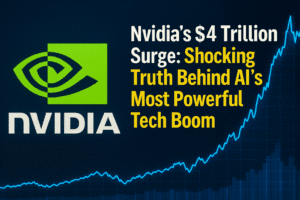Nvidia’s $4 Trillion Surge: Shocking Truth Behind AI’s Most Powerful Tech Boom
Nvidia’s $4 trillion valuation nearing India’s $4.2 trillion GDP is less about direct comparison and more a stark symbol of economic transformation. It highlights how investor faith in a single company’s future AI dominance rivals the annual output of a nation of 1.4 billion people. This reveals the immense, concentrated value placed on cutting-edge technology versus the diverse, tangible output of a vast traditional economy. While Nvidia’s paper wealth could surpass India’s GDP with a minor stock bump, GDP reflects real goods and services, whereas market cap hinges on volatile expectations.
Ultimately, this milestone forces us to question how we measure value in the modern age and underscores the urgent need to ensure technological wealth translates into broader societal progress, not just shareholder returns.

Nvidia’s $4 Trillion Surge: Shocking Truth Behind AI’s Most Powerful Tech Boom
When a single company’s stock market value ($4 trillion) nears the annual economic output of India—a nation of 1.4 billion people with millennia of civilization—it’s not just a financial statistic. It’s a mirror reflecting tectonic shifts in how the world creates value.
Decoding the Comparison
- Nvidia’s Valuation = Investor confidence in future AI dominance.
- India’s GDP = Sum of all goods/services produced across agriculture (19% of GDP), manufacturing (17%), and services (54%) in 2024.
The contrast? One represents concentrated technological speculation; the other, the lived reality of billions.
Why This Moment Matters
- The AI Acceleration Effect
Nvidia’s 24% annual surge isn’t just growth—it’s a feedback loop. Startups like Perplexity AI (launching the Comet browser) amplify demand for Nvidia chips, which in turn fuel more AI breakthroughs. This self-reinforcing cycle rewards shareholders disproportionately.
- The Fragility of Paper Wealth
A 5% stock swing could technically “overtake” India’s GDP in market cap terms. But unlike GDP—grounded in tangible output—Nvidia’s value hinges on sustained AI hype, supply chain stability, and zero regulatory surprises.
- The Innovation Paradox
While India builds factories, roads, and schools to lift living standards, Nvidia’s rise showcases how intangible assets (AI algorithms, chip designs) now outpace physical infrastructure in capturing investor imagination.
The Bigger Picture: Value vs. Values
- For India: The GDP comparison is a wake-up call. Can it leverage its own tech talent to convert economic scale into homegrown innovation?
- For Investors: Does betting $4 trillion on AI risk inflating a bubble, or is this the new foundation of global productivity?
- For Society: If one firm’s chips enable AI that could displace millions of jobs, how do we measure “value” beyond shareholder returns?
The Road Ahead
Nvidia’s ascent symbolizes capitalism’s evolving frontier. But true economic resilience lies in balance—between silicon and soil, algorithms and human welfare. As India climbs toward a $5 trillion GDP target, its challenge isn’t outpacing a stock chart. It’s ensuring that the AI revolution doesn’t widen the gap between market valuations and meaningful progress.
You must be logged in to post a comment.